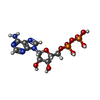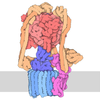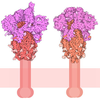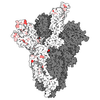+ Open data
Open data
- Basic information
Basic information
| Entry | Database: PDB / ID: 9cfc | |||||||||||||||
|---|---|---|---|---|---|---|---|---|---|---|---|---|---|---|---|---|
| Title | Cryo-EM structure of human kidney V-ATPase state 2 | |||||||||||||||
 Components Components |
| |||||||||||||||
 Keywords Keywords | MEMBRANE PROTEIN / human / kidney / V-ATPase | |||||||||||||||
| Function / homology |  Function and homology information Function and homology informationproton-transporting two-sector ATPase complex / Ion channel transport / plasma membrane proton-transporting V-type ATPase complex / Regulation of MITF-M-dependent genes involved in lysosome biogenesis and autophagy / intracellular pH reduction / eye pigmentation / central nervous system maturation / ATPase-coupled ion transmembrane transporter activity / rostrocaudal neural tube patterning / positive regulation of transforming growth factor beta1 production ...proton-transporting two-sector ATPase complex / Ion channel transport / plasma membrane proton-transporting V-type ATPase complex / Regulation of MITF-M-dependent genes involved in lysosome biogenesis and autophagy / intracellular pH reduction / eye pigmentation / central nervous system maturation / ATPase-coupled ion transmembrane transporter activity / rostrocaudal neural tube patterning / positive regulation of transforming growth factor beta1 production / Golgi lumen acidification / synaptic vesicle lumen acidification / vacuolar transport / proton-transporting V-type ATPase, V0 domain / extrinsic component of synaptic vesicle membrane / Transferrin endocytosis and recycling / cellular response to increased oxygen levels / vacuolar proton-transporting V-type ATPase, V1 domain / endosome to plasma membrane protein transport / vacuolar proton-transporting V-type ATPase, V0 domain / clathrin-coated vesicle membrane / lysosomal lumen acidification / endosomal lumen acidification / XBP1(S) activates chaperone genes / proton-transporting V-type ATPase complex / Amino acids regulate mTORC1 / head morphogenesis / protein localization to cilium / vacuolar proton-transporting V-type ATPase complex / osteoclast development / ROS and RNS production in phagocytes / vacuolar acidification / regulation of cellular pH / dendritic spine membrane / azurophil granule membrane / microvillus / proton transmembrane transporter activity / ATPase activator activity / regulation of MAPK cascade / autophagosome membrane / tertiary granule membrane / ficolin-1-rich granule membrane / proton-transporting ATPase activity, rotational mechanism / cilium assembly / RHOA GTPase cycle / positive regulation of Wnt signaling pathway / regulation of macroautophagy / transporter activator activity / H+-transporting two-sector ATPase / ATP metabolic process / specific granule membrane / Metabolism of Angiotensinogen to Angiotensins / angiotensin maturation / Insulin receptor recycling / ruffle / receptor-mediated endocytosis of virus by host cell / proton-transporting ATP synthase activity, rotational mechanism / axon terminus / endoplasmic reticulum-Golgi intermediate compartment membrane / RNA endonuclease activity / proton transmembrane transport / receptor-mediated endocytosis / secretory granule / secretory granule membrane / small GTPase binding / transmembrane transport / phagocytic vesicle membrane / synaptic vesicle membrane / melanosome / positive regulation of canonical Wnt signaling pathway / signaling receptor activity / ATPase binding / Hydrolases; Acting on ester bonds / intracellular iron ion homeostasis / postsynaptic membrane / early endosome / lysosome / endosome / endosome membrane / nuclear speck / cilium / apical plasma membrane / Golgi membrane / axon / lysosomal membrane / external side of plasma membrane / focal adhesion / intracellular membrane-bounded organelle / ubiquitin protein ligase binding / centrosome / Neutrophil degranulation / endoplasmic reticulum membrane / protein-containing complex binding / perinuclear region of cytoplasm / Golgi apparatus / ATP hydrolysis activity / extracellular exosome / nucleoplasm / ATP binding / membrane Similarity search - Function | |||||||||||||||
| Biological species |  Homo sapiens (human) Homo sapiens (human) | |||||||||||||||
| Method | ELECTRON MICROSCOPY / single particle reconstruction / cryo EM / Resolution: 3.47 Å | |||||||||||||||
 Authors Authors | Zhang, Z. / Lyu, M. | |||||||||||||||
| Funding support |  United States, 1items United States, 1items
| |||||||||||||||
 Citation Citation |  Journal: To Be Published Journal: To Be PublishedTitle: Cryo-EM structure of human kidney V-ATPase state 2 Authors: Zhang, Z. / Lyu, M. | |||||||||||||||
| History |
|
- Structure visualization
Structure visualization
| Structure viewer | Molecule:  Molmil Molmil Jmol/JSmol Jmol/JSmol |
|---|
- Downloads & links
Downloads & links
- Download
Download
| PDBx/mmCIF format |  9cfc.cif.gz 9cfc.cif.gz | 1.2 MB | Display |  PDBx/mmCIF format PDBx/mmCIF format |
|---|---|---|---|---|
| PDB format |  pdb9cfc.ent.gz pdb9cfc.ent.gz | Display |  PDB format PDB format | |
| PDBx/mmJSON format |  9cfc.json.gz 9cfc.json.gz | Tree view |  PDBx/mmJSON format PDBx/mmJSON format | |
| Others |  Other downloads Other downloads |
-Validation report
| Summary document |  9cfc_validation.pdf.gz 9cfc_validation.pdf.gz | 1.2 MB | Display |  wwPDB validaton report wwPDB validaton report |
|---|---|---|---|---|
| Full document |  9cfc_full_validation.pdf.gz 9cfc_full_validation.pdf.gz | 1.3 MB | Display | |
| Data in XML |  9cfc_validation.xml.gz 9cfc_validation.xml.gz | 175.4 KB | Display | |
| Data in CIF |  9cfc_validation.cif.gz 9cfc_validation.cif.gz | 283.6 KB | Display | |
| Arichive directory |  https://data.pdbj.org/pub/pdb/validation_reports/cf/9cfc https://data.pdbj.org/pub/pdb/validation_reports/cf/9cfc ftp://data.pdbj.org/pub/pdb/validation_reports/cf/9cfc ftp://data.pdbj.org/pub/pdb/validation_reports/cf/9cfc | HTTPS FTP |
-Related structure data
| Related structure data |  45536MC M: map data used to model this data C: citing same article ( |
|---|---|
| Similar structure data | Similarity search - Function & homology  F&H Search F&H Search |
- Links
Links
- Assembly
Assembly
| Deposited unit | 
|
|---|---|
| 1 |
|
- Components
Components
-V-type proton ATPase ... , 12 types, 28 molecules 0123456789ABCDEFGHIJKLMNQRSU
| #1: Protein | Mass: 21418.213 Da / Num. of mol.: 1 / Source method: isolated from a natural source / Source: (natural)  Homo sapiens (human) / References: UniProt: Q99437 Homo sapiens (human) / References: UniProt: Q99437 | ||||||||||||||||||||
|---|---|---|---|---|---|---|---|---|---|---|---|---|---|---|---|---|---|---|---|---|---|
| #2: Protein | Mass: 15743.655 Da / Num. of mol.: 9 / Source method: isolated from a natural source / Source: (natural)  Homo sapiens (human) / References: UniProt: P27449 Homo sapiens (human) / References: UniProt: P27449#3: Protein | Mass: 68379.875 Da / Num. of mol.: 3 / Source method: isolated from a natural source / Source: (natural)  Homo sapiens (human) Homo sapiens (human)References: UniProt: P38606, H+-transporting two-sector ATPase #4: Protein | Mass: 56561.500 Da / Num. of mol.: 3 / Source method: isolated from a natural source / Source: (natural)  Homo sapiens (human) / References: UniProt: P21281 Homo sapiens (human) / References: UniProt: P21281#5: Protein | | Mass: 28311.918 Da / Num. of mol.: 1 / Source method: isolated from a natural source / Source: (natural)  Homo sapiens (human) / References: UniProt: Q9Y5K8 Homo sapiens (human) / References: UniProt: Q9Y5K8#6: Protein | Mass: 26183.346 Da / Num. of mol.: 3 / Source method: isolated from a natural source / Source: (natural)  Homo sapiens (human) / References: UniProt: P36543 Homo sapiens (human) / References: UniProt: P36543#7: Protein | Mass: 13781.547 Da / Num. of mol.: 3 / Source method: isolated from a natural source / Source: (natural)  Homo sapiens (human) / References: UniProt: O75348 Homo sapiens (human) / References: UniProt: O75348#8: Protein | | Mass: 13388.210 Da / Num. of mol.: 1 / Source method: isolated from a natural source / Source: (natural)  Homo sapiens (human) / References: UniProt: Q16864 Homo sapiens (human) / References: UniProt: Q16864#9: Protein | | Mass: 40369.949 Da / Num. of mol.: 1 / Source method: isolated from a natural source / Source: (natural)  Homo sapiens (human) / References: UniProt: P61421 Homo sapiens (human) / References: UniProt: P61421#10: Protein | | Mass: 96512.414 Da / Num. of mol.: 1 / Source method: isolated from a natural source / Source: (natural)  Homo sapiens (human) / References: UniProt: Q93050 Homo sapiens (human) / References: UniProt: Q93050#11: Protein | | Mass: 9380.329 Da / Num. of mol.: 1 / Source method: isolated from a natural source / Source: (natural)  Homo sapiens (human) / References: UniProt: O15342 Homo sapiens (human) / References: UniProt: O15342#13: Protein | | Mass: 52067.480 Da / Num. of mol.: 1 / Source method: isolated from a natural source / Source: (natural)  Homo sapiens (human) / References: UniProt: Q15904 Homo sapiens (human) / References: UniProt: Q15904 |
-Protein , 2 types, 2 molecules TV
| #12: Protein | Mass: 15435.220 Da / Num. of mol.: 1 / Source method: isolated from a natural source / Source: (natural)  Homo sapiens (human) Homo sapiens (human)References: UniProt: Q6P5S7, Hydrolases; Acting on ester bonds |
|---|---|
| #14: Protein | Mass: 39045.855 Da / Num. of mol.: 1 / Source method: isolated from a natural source / Source: (natural)  Homo sapiens (human) / References: UniProt: O75787 Homo sapiens (human) / References: UniProt: O75787 |
-Non-polymers , 1 types, 1 molecules 
| #15: Chemical | ChemComp-ADP / |
|---|
-Details
| Has ligand of interest | N |
|---|---|
| Has protein modification | Y |
-Experimental details
-Experiment
| Experiment | Method: ELECTRON MICROSCOPY |
|---|---|
| EM experiment | Aggregation state: PARTICLE / 3D reconstruction method: single particle reconstruction |
- Sample preparation
Sample preparation
| Component | Name: V-ATPase / Type: COMPLEX / Entity ID: #1-#14 / Source: NATURAL |
|---|---|
| Source (natural) | Organism:  Homo sapiens (human) Homo sapiens (human) |
| Buffer solution | pH: 7.5 |
| Specimen | Embedding applied: NO / Shadowing applied: NO / Staining applied: NO / Vitrification applied: YES |
| Vitrification | Cryogen name: ETHANE |
- Electron microscopy imaging
Electron microscopy imaging
| Experimental equipment |  Model: Titan Krios / Image courtesy: FEI Company |
|---|---|
| Microscopy | Model: FEI TITAN KRIOS |
| Electron gun | Electron source:  FIELD EMISSION GUN / Accelerating voltage: 300 kV / Illumination mode: FLOOD BEAM FIELD EMISSION GUN / Accelerating voltage: 300 kV / Illumination mode: FLOOD BEAM |
| Electron lens | Mode: BRIGHT FIELD / Nominal defocus max: 1500 nm / Nominal defocus min: 800 nm |
| Image recording | Electron dose: 38 e/Å2 / Film or detector model: GATAN K3 BIOQUANTUM (6k x 4k) |
- Processing
Processing
| EM software | Name: PHENIX / Version: 1.20.1_4487: / Category: model refinement | ||||||||||||||||||||||||
|---|---|---|---|---|---|---|---|---|---|---|---|---|---|---|---|---|---|---|---|---|---|---|---|---|---|
| CTF correction | Type: PHASE FLIPPING AND AMPLITUDE CORRECTION | ||||||||||||||||||||||||
| 3D reconstruction | Resolution: 3.47 Å / Resolution method: FSC 0.143 CUT-OFF / Num. of particles: 24168 / Symmetry type: POINT | ||||||||||||||||||||||||
| Refine LS restraints |
|
 Movie
Movie Controller
Controller






 PDBj
PDBj












